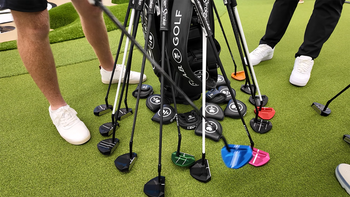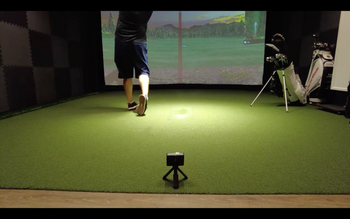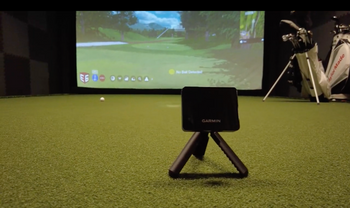You'll want at least a 10' x 15' x 9' space for a golf simulator that works well, but bigger is definitely better if you want comfortable, unrestricted swings. You can't skip on the essential gear: a launch monitor, a bright projector putting out at least 3,800 lumens, a decent computer that can handle gaming, and a solid hitting mat. For your impact screen, go with something around 10' x 5.6' and mount it about 12 inches from the wall with strong hardware. Keep in mind that your choice of launch monitor really matters - if you're going with a radar-based system, you'll need extra room behind where you're hitting. Getting all these details right, from where you place everything to which gear you pick, will make or break how well your simulator performs.
Key Features
Minimum room dimensions should be 10' x 12' x 8.5', with larger spaces preferred for comfortable swings and equipment setup
Launch monitors require either 6-10 feet behind hitting area (radar-based) or adjacent placement (photometric) for accurate tracking.
Install impact screens 12 inches from back wall with secure mounting, sized 10' x 5.63' for optimal 16:9 display ratio.
Select a projector with minimum 3800 lumens brightness and high-quality golf mat for realistic ball feedback.
Position hitting area 10-15 feet from impact screen to ensure proper ball flight tracking and safety.
Room Dimensions and Layout Requirements
You'll need to check if your space meets the basic size requirements before setting up your golf simulator. While you can work with an 8.5-foot ceiling, it's better to have 9-10 feet for comfortable swings - especially if you're tall or have a big backswing.
When it comes to width, don't go smaller than 10 feet. A space of 12-15 feet is ideal since it'll give you plenty of room to work on your form without hitting the walls. Keep in mind that different launch monitors might need different amounts of space.
For depth, you'll need at least 12 feet, but try to get 16-18 feet if you can. This extra room makes sure you've got enough space for your launch monitor, some room behind where you'll stand, and the gap you need between your impact screen and the wall. Before you lock in your room layout, do some practice swings to make sure you've got enough space for all your clubs.
d get the ball in the air easier. Better players may prefer lower lofts for more control over their shots.
How fast you swing also matters a lot. Players with high swing speeds can use lower lofts and still get enough backspin, while slower swingers often need more loft to get the right launch.
The course conditions impact club selection, too. Higher lofts work better from soft fairways, so the ball doesn't bury in the turf. Low lofts can give you a bonus distance on firm ground.
So before you buy your next set of clubs, think about your game, your swing, and where you play. Dialing in the best loft setup will help you shoot lower scores and have more fun.
Crucial Equipment Selection

Setting up a golf simulator doesn't have to be complicated - you just need the right gear to create an amazing experience. You'll need four key pieces: a solid launch monitor like, a bright projector (at least 3800 lumens) for clear visuals, a computer that can handle intense graphics, and a quality golf mat for realistic shots.
Don't cut corners on your launch monitor - it's the core of your simulator since it tracks crucial data like ball speed and spin rate. Your projector needs to be bright enough for sharp images, and your computer should pack enough power to run the software without hiccups. Want to step up your practice? Add some alignment sticks to perfect your stance and aim. And when it comes to the mat, go for quality brands like Indoor Golf Design’s hitting mats, they’ll give you the real feel and feedback you need to improve your game.
Impact Screen Setup
Your golf simulator's visual experience depends heavily on a well-installed impact screen. For most home setups, go with at least a 16:9 screen that's 10 feet wide by 5.63 feet tall - it'll give you the most immersive experience and help track your ball flight accurately.
When it's time to mount your screen, keep it at least 12 inches away from the back wall. Use heavy-duty eye bolts and strong screws to hang it securely. Metal slotted angle makes for a great mounting solution since it's stable and reliable. Don't forget tarp clips - they're essential for adjusting tension and getting rid of ripples that mess with your picture quality. Keep an eye on your screen with regular maintenance checks, and make sure it's properly tensioned to prevent balls from bouncing back too hard. This'll keep both you and your equipment safe while you play.
Launch Monitor Space Planning
Setting up your launch monitor correctly depends on what type you've got and how much space you have. If you're using a radar system like the Garmin R10 or Trackman 4, you'll need 6-10 feet of space behind where you're hitting. On the other hand, camera-based systems like the SkyTrak+ or GC3 can sit right next to your hitting area. These camera systems are actually more accurate in smaller spaces, which makes them perfect for home setups.
Just remember that radar units work best when there's more distance between you and the impact screen to track the ball's flight. Camera systems don't need as much room since they're just capturing what happens at impact.
Commercial Bay Design Considerations
For a commercial simulator bay, safety and durability are key. We recommend using a triple-layer impact screen with a velcro border - it's easy to maintain and replace when needed. You'll also want premium hitting mats with solid rubber bases to handle regular use. To make the space feel more authentic, add some ambient lighting, comfortable seating, and realistic turf that'll make players feel like they're actually on the course. Top it off with the right tech and analytics tools, and you've got yourself a professional training facility that serious golfers will love.

Frequently Asked Questions
How Long Does It Typically Take to Install a Complete Golf Simulator Setup?
You'll typically need between 4-12 hours for a complete golf simulator installation, depending on your setup's complexity and whether you're going with professional help. While basic systems might take just a few hours, high-end setups with projectors, impact screens, and launch monitors can require a full day. Don't forget, factors like download times, connectivity issues, and precise calibration needs can extend your installation timeline.
Can Multiple Players Use the Simulator Simultaneously for Competitive Play?
You can't have multiple players hitting simultaneously, as golf simulators are designed for one player at a time. However, you'll find plenty of multiplayer options through turn-based play, supporting up to 4 local players or 8 players in peer-to-peer online matches. While you're waiting for your turn, you can enjoy different game modes like Stroke, Scramble, or Best Ball, making it a social experience despite the sequential play format.
What Flooring Material Works Best for a Home Golf Simulator Room?
For ideal performance, you'll want to use interlocking EVA foam tiles as your base layer, topped with high-quality turf or SIGPRO flooring. EVA foam provides vital shock absorption and comfort, while the turf layer delivers a realistic feel for your shots. If you're on a budget, puzzle-fit foam tiles work well, but don't skip the foam foundation - it's necessary for protecting your equipment and joints during those marathon practice sessions.
How Often Should Impact Screens and Hitting Mats Be Replaced?
Just like a boxer's gloves take a beating, your simulator gear needs regular replacement. You'll typically need to swap out impact screens every 1-2 years with heavy use, though some can last longer with proper care. Your hitting mat's lifespan varies more dramatically - expect 3-5 years from artificial turf mats and 5-7 years from rubber ones, depending on your usage intensity and maintenance routine.
Do Golf Simulators Require Special Electrical or Internet Connectivity Requirements?
You'll need reliable power setups with multiple 120V outlets for your simulator's projector, computer, and launch monitor. Most systems draw significant power, especially with 5,000+ lumen projectors and HVAC systems running. As for internet, you'll want a stable connection for software updates and online features like multiplayer modes and course downloads, though many simulators can run offline if needed.
Conclusion
You're all set to build your dream indoor golf space, where you'll practice your swing no matter the weather outside. Whether you're working with a snug basement or roomy garage, taking time to plan your layout and setup will make a huge difference. From getting the dimensions right to placing your equipment perfectly, every detail matters. Now's the time to transform that empty space into your personal golf haven that you can use all year round.





